Web Scraping
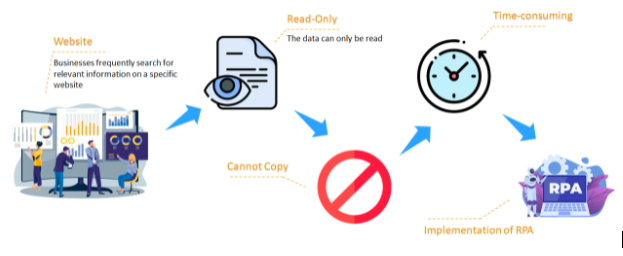
The first RPA projects is web scraping. It is also known as web harvesting, web automation, screen scraping, and web data extraction because of its function. Scraping is a method of extracting a vast amount of data from a website and saving it to a local file or database.
Businesses frequently search for relevant information on a competitor's or a specific website. However, the data on most websites can only be read, there is no way to copy it for personal use. As a result, it warrants a time-consuming action of copying and pasting data. In a fraction of the time, you can accomplish this with Robotic Process Automation.
The web scraping software is programmed to load and extract the relevant data automatically. As a result, you'll save energy and money. Various businesses use web scraping, from e-commerce stores to stock dealers, to get data. Manual web scraping, on the other hand, might be very costly.
CRM Upgrading
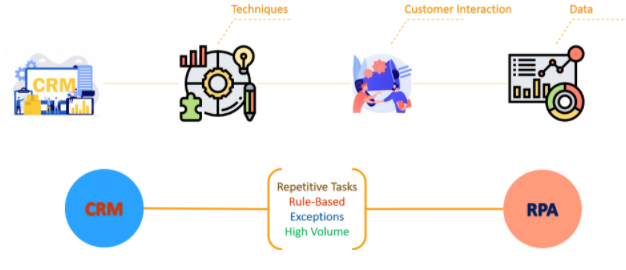
Customer relationship management (CRM) is a set of techniques, methods, and technologies for managing customer interactions and data. CRM is used to increase customer interactions, loyalty, and sales across the customer life cycle
Employees in this field typically have basic, repetitive, and rule-based work with moderate or high volumes, making this an excellent choice for RPA, where a bot replaces human effort. Experts have designed RPA systems to handle tasks like this. RPA can perform repetitive, rule-based, and high-volume activities with ease.
CRM systems collect data about clients from many channels and points of interaction. The company's website, phone, live chat, direct mail, marketing materials, and social media are examples of these channels.
RPA systems are already in use and completely functional. They can accomplish any repetitive task that a human undertakes in a more innovative way using cognitive technologies. Because of the high cost and operations management benefits provided by RPA, experts project a significant shift in business processes to occur very soon.
Call Center Operations
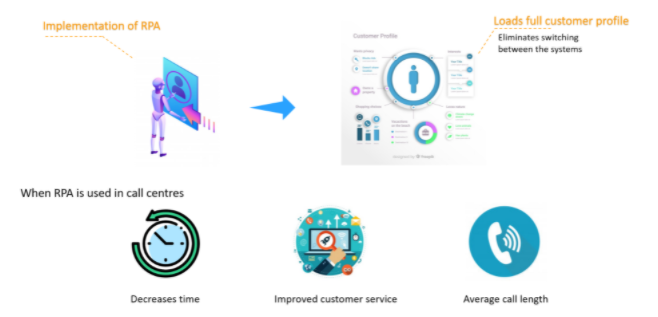
When a customer contacts an agent, the agent must first identify them in the system to obtain relevant data such as order status, order number, pending support tickets, shipment ID, etc. This requires the agent to interact with the customer while simultaneously moving from one system to another. The database contains the customer's information and the other system, which includes additional information.
Customers must wait while the representative is busy dealing with data, sometimes asking for information already requested. This decreases customer satisfaction and extends call duration
RPA takes a user-friendly approach to data integration and process management. It eliminates the need to switch between different applications by loading a complete customer profile from numerous systems by automating application launches, mouse clicks, and field entries.
When you use RPA in call centers, it drastically decreases the time it takes to locate a customer in the system and examine all information about them on a single screen. As a result, the customer does not have to wait for the agent to load all the information, resulting in improved customer service and a shorter average call length.
Onboarding Employees

HR is one department that is actively considering introducing RPA into its working procedures, focusing on the onboarding process.
The onboarding process prepares new employees for their new workplace by providing them with the essential knowledge, skills, and behaviors. This process usually begins before the first day of work and is a crucial aspect of integrating a newly hired employee into the organization’s payroll and internal databases.
Employee onboarding sets the tone for a new employee's career with the organization. Yet, mostly, onboarding new staff is still a tedious and wasteful procedure. RPA improves HR procedures that are still run on older systems, such as onboarding, by adding new functionality, decreasing human error, and securing data.
The organizations could cut the processing time to 3-4 minutes per new employee using a combination of RPA bots. The greater accuracy of the automation also reduced the time required for examining and rectifying problems previously. The organization optimized data input, resource allocation, and error handling by monitoring the automated process.
The tasks performed by RPA bots in the onboarding process are as follows:
Payroll Processing
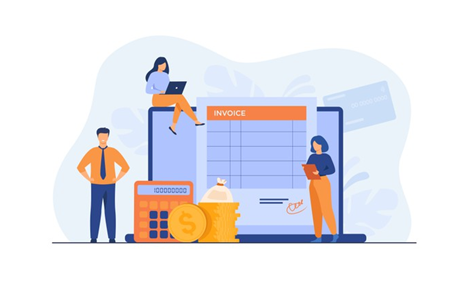
Payroll processing is a critical company operation that involves calculating employees' net pay after deducting applicable taxes and deductions.
Payroll processing is one of the most important and one of the most time-consuming operations in any company. Because of the importance of accuracy to avoid stiff IRS penalties, manually updating payroll systems is complex and potentially costly. Because of the high risk and the time-consuming nature of manually updating records, businesses have turned to automation to reduce mistake rates and time wasted.
By implementing RPA, all payroll updates received through email from customers are handled by the RPA bot, which automatically inputs them into the SAP system. In approximately a few weeks, the RPA solution was up and running, automating 90% of the previous labor necessary to process these requests.
Legal Process

RPA in the legal process means that your lawyers and specialists will be able to respond quickly to rising client and internal stakeholder demands in terms of legal and compliance processes. In-house legal departments and independent law firms both can benefit from Robotic Process Automation solutions for legal. This frees up all of your highly qualified legal professionals to focus on what matters most: learning the law and providing the best legal advice possible to clients.
RPA automates operations on top of existing systems, such as legal documents, spreadsheets, pdf, scanned documents, websites, and apps like e-discovery tools, contract management systems, and more. In a simple editor, you can quickly design robots. Even lawyers and barristers can develop their automation.
Data Wiring for Healthcare

Healthcare providers strive to provide high-quality care to as many people as possible. However, both providers and payers must complete and handle various forms, documentation, and data. It collects all the data like patient records, provider information, and billing and payment information, processed, filed, and stored in a mess of segregated and separate systems.
RPA is a tool that aids in the digital transformation process. In a nutshell, it's the wiring that connects all the data in all systems in a way that's faster, more accurate, and more efficient than traditional IT approaches like complex business process management systems and custom application program interfaces (APIs) and others.
RPA combined with artificial intelligence (AI) can swiftly and accurately push and draw many data from one system to another. In addition to speeding up the system, it frees up humans to undertake more value-added work by removing time-consuming, low-value jobs from their hands.
Claims Processing
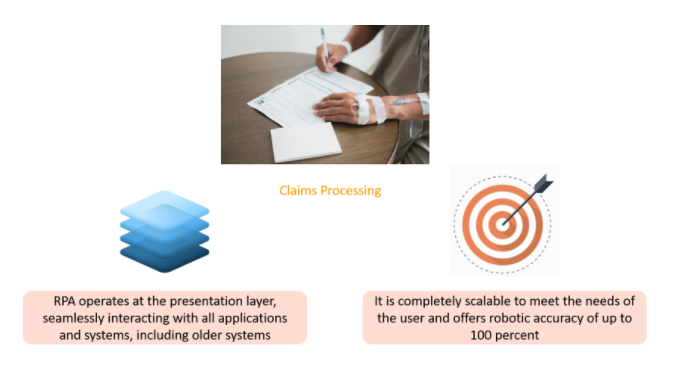
Claims processing is at the core of the insurance industry. The insurance company satisfies its commitment to its consumers, establishes service standards, builds credibility, and performs its obligations at this stage. It entails multiple administrative, managerial, and customer service functions, all of which are characterized by data-intensive manual labor and troublesome document formats.
Many insurers have already implemented automation, whether it's simple tasks like scanning PDF documents or more extensive workflow automation. On the other hand, these solutions are different, and each has its own set of issues. This adds to the complexity and difficulty of processing.
This complicates the claims process, exposes it to errors, and adds to the expense. This is where RPA enters the picture as a fully integrated, end-to-end automation solution that overcomes the existing issues.
RPA operates at the presentation layer, seamlessly interacting with all applications and systems, including older systems. It is entirely scalable to meet the user’s needs and offers robotic accuracy of up to 100 percent.

Copyright 2026 Thixpro. All rights reserved.



